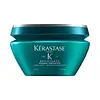What's inside
What's inside
 Key Ingredients
Key Ingredients

No key ingredients
 Benefits
Benefits

 Concerns
Concerns

 Ingredients Side-by-side
Ingredients Side-by-side

Water
Skin ConditioningCetearyl Alcohol
EmollientBehentrimonium Chloride
PreservativeCandelilla Cera
EmollientAmodimethicone
Cetyl Esters
EmollientIsopropyl Alcohol
SolventGlycerin
HumectantPhenoxyethanol
PreservativeTrideceth-6
EmulsifyingLinalool
PerfumingLactic Acid
BufferingHexyl Cinnamal
PerfumingChlorhexidine Digluconate
AntimicrobialCetrimonium Chloride
AntimicrobialLimonene
PerfumingSodium Hydroxide
BufferingChenopodium Quinoa Seed Extract
Skin ConditioningHydroxypropyltrimonium Hydrolyzed Wheat Protein
Skin ConditioningCI 19140
Cosmetic ColorantCI 15985
Cosmetic ColorantParfum
MaskingWater, Cetearyl Alcohol, Behentrimonium Chloride, Candelilla Cera, Amodimethicone, Cetyl Esters, Isopropyl Alcohol, Glycerin, Phenoxyethanol, Trideceth-6, Linalool, Lactic Acid, Hexyl Cinnamal, Chlorhexidine Digluconate, Cetrimonium Chloride, Limonene, Sodium Hydroxide, Chenopodium Quinoa Seed Extract, Hydroxypropyltrimonium Hydrolyzed Wheat Protein, CI 19140, CI 15985, Parfum
Water
Skin ConditioningCetearyl Alcohol
EmollientParaffinum Liquidum
EmollientOrbignya Oleifera Seed Oil
EmollientDipalmitoylethyl Hydroxyethylmonium Methosulfate
Parfum
MaskingCetyl Esters
EmollientCetrimonium Chloride
AntimicrobialCaprylyl Glycol
EmollientLinalool
PerfumingCitric Acid
Buffering2-Oleamido-1,3-Octadecanediol
Skin ConditioningCitronellol
PerfumingBHT
AntioxidantGlycine
BufferingArginine
MaskingProline
Skin ConditioningTyrosine
MaskingGlutamic Acid
HumectantGeraniol
PerfumingSerine
MaskingHydroxypropyltrimonium Hydrolyzed Wheat Protein
Skin ConditioningBenzyl Alcohol
PerfumingSafflower Glucoside
Isoeugenol
PerfumingGlycerin
HumectantTrehalose
HumectantTamarindus Indica Seed Polysaccharide
Skin ConditioningMyrothamnus Flabellifolia Leaf Extract
EmollientWater, Cetearyl Alcohol, Paraffinum Liquidum, Orbignya Oleifera Seed Oil, Dipalmitoylethyl Hydroxyethylmonium Methosulfate, Parfum, Cetyl Esters, Cetrimonium Chloride, Caprylyl Glycol, Linalool, Citric Acid, 2-Oleamido-1,3-Octadecanediol, Citronellol, BHT, Glycine, Arginine, Proline, Tyrosine, Glutamic Acid, Geraniol, Serine, Hydroxypropyltrimonium Hydrolyzed Wheat Protein, Benzyl Alcohol, Safflower Glucoside, Isoeugenol, Glycerin, Trehalose, Tamarindus Indica Seed Polysaccharide, Myrothamnus Flabellifolia Leaf Extract
Ingredients Explained
These ingredients are found in both products.
Ingredients higher up in an ingredient list are typically present in a larger amount.
Cetearyl alcohol is a mixture of two fatty alcohols: cetyl alcohol and stearyl alcohol. It is mainly used as an emulsifier. Emulsifiers help prevent the separation of oils and products. Due to its composition, it can also be used to thicken a product or help create foam.
Cetearyl alcohol is an emollient. Emollients help soothe and hydrate the skin by trapping moisture.
Studies show Cetearyl alcohol is non-toxic and non-irritating. The FDA allows products labeled "alcohol-free" to have fatty alcohols.
This ingredient is usually derived from plant oils such as palm, vegetable, or coconut oils. There is debate on whether this ingredient will cause acne.
Due to the fatty acid base, this ingredient may not be Malassezia folliculitis safe.
Learn more about Cetearyl AlcoholThis ingredient is a preservative, antimicrobial, and emulsifier. It is often used in cosmetics for its ability to cleanse, condition, and reduce static.
Cetrimonium chloride is a quaternary ammonium salt, meaning it has a water-soluble structure.
Cetyl Esters is a synthetic wax made up of mostly fatty acids and fatty alcohols. It is strcturally similar to wax taken from whales.
As an emollient, it creates a thin barrier on the skin. This barrier prevents moisture from escaping.
This ingredient may not be fungal-acne safe.
Learn more about Cetyl EstersGlycerin is already naturally found in your skin. It helps moisturize and protect your skin.
A study from 2016 found glycerin to be more effective as a humectant than AHAs and hyaluronic acid.
As a humectant, it helps the skin stay hydrated by pulling moisture to your skin. The low molecular weight of glycerin allows it to pull moisture into the deeper layers of your skin.
Hydrated skin improves your skin barrier; Your skin barrier helps protect against irritants and bacteria.
Glycerin has also been found to have antimicrobial and antiviral properties. Due to these properties, glycerin is often used in wound and burn treatments.
In cosmetics, glycerin is usually derived from plants such as soybean or palm. However, it can also be sourced from animals, such as tallow or animal fat.
This ingredient is organic, colorless, odorless, and non-toxic.
Glycerin is the name for this ingredient in American English. British English uses Glycerol/Glycerine.
Learn more about GlycerinWe don't have a description for Hydroxypropyltrimonium Hydrolyzed Wheat Protein yet.
Linalool is a fragrance and helps add scent to products. It's derived from common plants such as cinnamon, mint, citrus, and lavender.
Like Limonene, this ingredient oxidizes when exposed to air. Oxidized linalool can cause allergies and skin sensitivity.
This ingredient has a scent that is floral, spicy tropical, and citrus-like.
Learn more about LinaloolParfum is a catch-all term for an ingredient or more that is used to give a scent to products.
Also called "fragrance", this ingredient can be a blend of hundreds of chemicals or plant oils. This means every product with "fragrance" or "parfum" in the ingredients list is a different mixture.
For instance, Habanolide is a proprietary trade name for a specific aroma chemical. When used as a fragrance ingredient in cosmetics, most aroma chemicals fall under the broad labeling category of “FRAGRANCE” or “PARFUM” according to EU and US regulations.
The term 'parfum' or 'fragrance' is not regulated in many countries. In many cases, it is up to the brand to define this term.
For instance, many brands choose to label themselves as "fragrance-free" because they are not using synthetic fragrances. However, their products may still contain ingredients such as essential oils that are considered a fragrance by INCI standards.
One example is Calendula flower extract. Calendula is an essential oil that still imparts a scent or 'fragrance'.
Depending on the blend, the ingredients in the mixture can cause allergies and sensitivities on the skin. Some ingredients that are known EU allergens include linalool and citronellol.
Parfum can also be used to mask or cover an unpleasant scent.
The bottom line is: not all fragrances/parfum/ingredients are created equally. If you are worried about fragrances, we recommend taking a closer look at an ingredient. And of course, we always recommend speaking with a professional.
Learn more about ParfumWater. It's the most common cosmetic ingredient of all. You'll usually see it at the top of ingredient lists, meaning that it makes up the largest part of the product.
So why is it so popular? Water most often acts as a solvent - this means that it helps dissolve other ingredients into the formulation.
You'll also recognize water as that liquid we all need to stay alive. If you see this, drink a glass of water. Stay hydrated!
Learn more about Water